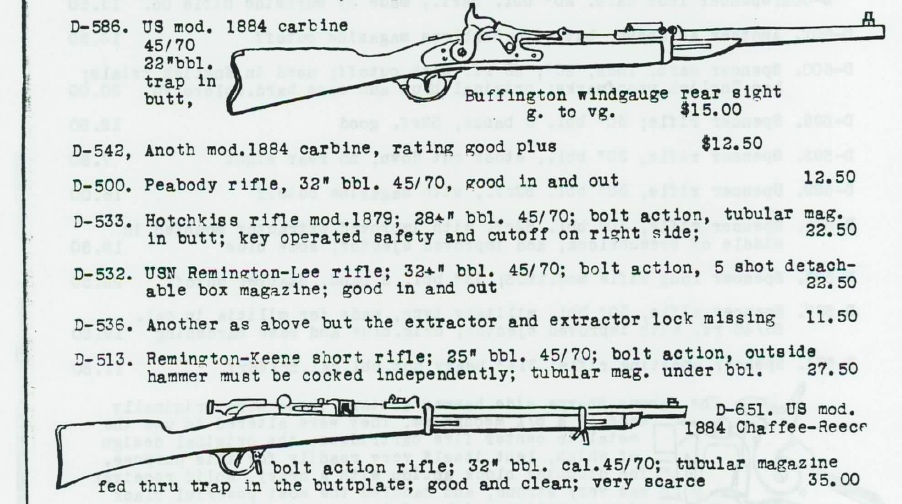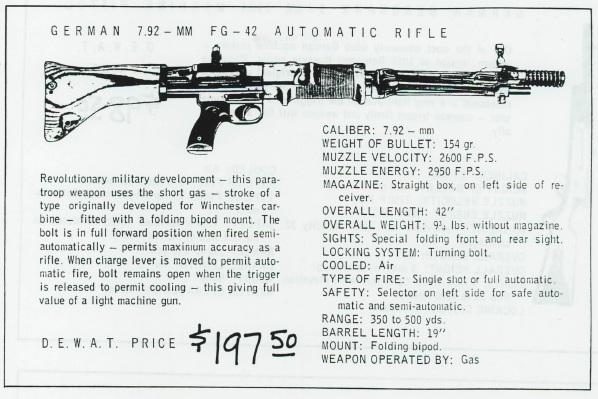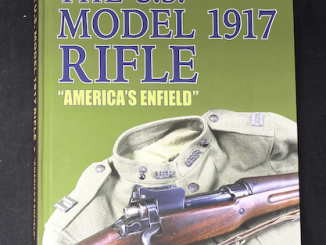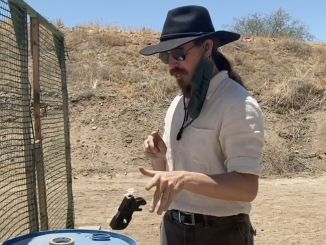…because it won’t get any cheaper or easier to find. Military guns, that is. Part of the human psyche, I think, tends to disregard the value of things that are plentiful and inexpensive (or even just fairly easy to obtain) on grounds that they will always be there later. Then a few years later we go back to see when they’ve thinned out, and presto, the price has doubled or tripled…or worse. My suggestion? If it’s something that appeals to you, buy it today. In ten or twenty years you’ll be looking wistfully at that J&G catalog because that one boring Polish pistol has become completely impossibly to find, and you really need it to round out your collection.

The secret to a lot of the amazing collections we see today isn’t that the owner is a gazillionaire (although certainly some of them are). The key to many is simply that someone had the foresight and interest to buy things when they were available. It’s a bit of an extreme example, but decades ago there wasn’t much interest in C93 Borchardt pistols, because they were just so ungainly – and so you could get one for a reasonable sum. I’m sure most folks simply went with the crowd and ignored them…who wants that clumsy old thing anyway, when we can get a shiny Luger instead? But the few who bucked the trend are the few who are able to have one today without dropping 5 figures for it.

Okay, I know someone is going to bring up inflation in response to these ads. Well, that FG42 ad is from 1956 (Hy Hunter’s American Weapons Corporation, Burbank, CA). In today’s dollars, it would set you back about $1650. Does that still sound like a deal you would consider? Too much money? Maybe you would prefer an RSC 1917 French selfloader for $55?
So, I’m not saying we should all go drain our bank accounts and buy as many guns as we can (although I realize the idea is always a bit tempting). No, I’m suggesting that when you find something you want, you should consider how likely you will be to find it in 10 years and how much it will cost then. It is simply the nature of surplus that guns start common and inexpensive and disappear over time. We can see it in every single gun ever imported or sold as surplus, and yet we so often assume that the gun we see for sale today will somehow not be affected.
Of course, I would be remiss if I didn’t point out the exceptions that prove the rule. A friend of ours jumped at the chance to get an SKS in an even swap for a .38 Webley automatic pistol, and figured he got a pretty good deal. The was in the 50s, and it was one of the first SKS rifles to find its way to the US, straight from the Suez crisis. Interesting story aside, that rifle certainly lost some value when the freighter loads of SKS’s came into the country many years later…but that is very much the statistical outlier. We can see SKS prices climbing up right now, as importer supplies have dried up. Who doesn’t see the $350 price tags and not wish they had bought a few more at $89 each?
As for me, I’m trying to focus on Mosins. As I’ve said before, I really like the looks and history of the M1891 Mosin Nagant, and their prices are seriously held down by the still-significant glut of 91/30s on the market (same thing with rare Finnish Mosins). Those refurbished 91/30s are guaranteed to dry up sooner or later, and then the market will correct itself. So…if you want it, buy it today.





A friend of mine summarizes it as “The deal might not come back, and you can always get more money”
One of the best examples in the last 20 years is the SVT-40. I’m pretty sure mine was less than $300. Now they go for $750-$1000. Same thing for Polish M44s, they were less than $200 back in the early 1990s.
Don’t forget parts kits. I got my L1A1 kit for less than $200 in about 2000. I think the G1 kit was less than $150. In about 2006 Polish underfolder AK kits were still less than $300. All these with the original barrel.
Anybody want to trade a Suomi semi auto for a Glock G29SF?
Berdan II infantry and dragoon rifles were sold for about $20 in the 1950s, and nowadays Berdan Dragoon rifles are worth over $3000. Not bad investments. Good advice.
Just have a look. “www.gunmagazine.com.1956 issues/G11560pdf”.
My Johnson M1941 Semi-Automatic cost me 1500 3 years ago, it is in VG+ and shoots great. It is now valued at +- 2000+. My Spencer 56-56 was 1000 5yrs ago and I have been offered 2500 last month. Look what has happened to M1 Garands and M1 Carbine prices (REAL ONES) and anything that even comes close ti ever having been a “sniper” rifle is in the BIG money. Look at WW I, WW II and Korea War Colt 1911’s or A1’s to say nothing of Colt or S&W 1917 .45’s. Next up is no doubt the Vietnam era rebuilt 1911A1’s.
You are absolutely right! I have been noticing the steady increase in price for many surplus military rifles in the last 10 to 20 years… I fully agree with P161911 reg. the SVT 40. They became pricey and rarer. The same applies to a few other, once plentiful (and considerably less expensive) rifles (the Hakim and a few other self-loaders do spring to mind).
If I could travel back in time to when that catalog was published (first scan from top), I surely would buy both the .45-70 Hotchkiss M 1879 and the Chaffee-Reese rifles, Ian! And quite possibly the US Navy Remington-Lee too (or perhaps we could reach an agreement over the later one)! That RSC 1917 selfloader for $55 would be nice too…
Wanted good condition M1 Carbine bayonet.
I went to a Western Auto store in the mid 50’s with my dad and he dug thru several 55gal drums of surplus rifles. He ended up with a #3 Enfield for $13. Sure wish he had bought the drum full…
Ian, I agree thoroughly! I guess it’s time to go get that M1917 and P14 enfields!
I got my first sporterized Lee 1917 SHTLE for a mere $90. I got my Nagants 10 years ago for $45.00 for the 91/30 and $55.00 for the ’38 carbine. Treasure where you find it I guess. I could have had an SVT a few years ago for $300 but didn’t have the cash, same for the P14. Saw and AR10 (Semi) for a grand 5 years ago.
But part of the problem is that everyone with a gun to sell has the internet and marks up accordingly, and there are a lot more of us collecting for fun and sport. During the last wave of Jungle Carbines I spotted some good deals, but I also saw a jerk trying to unload a chopped down Lee for $400. Obvious fake, but dear lord someone bought it.
I think some of the factor with Mosins is that they weren’t that common in this country before the Soviets filed for Chapter 11.
When they started coming in in container loads and were stacked like cordwood at gun shows, there wasn’t much of a collector market and therefore not many people really knew all that much about them. It was their very cheapness and availability that made people collect them in the first place and that collecting drove people to research the rifle and determine which variants were rare and desirable…
Want a more recent example? U.S. military arms have exploded in price since 2000.
Pick up a Blue Book from a decade ago and compare the prices for 1911s, carbines, and Garands to the current one.
I bought a nice Eddystone 1917 from a friend ten years ago for ~$300 and felt like I was helping him out at that tariff, overpaying because he was a buddy in a pinch. Now I feel like mailing him a check to make up for some of the appreciation…
I thought this post was going to be about politics.
I was pleasantly surprised.
I have a couple of really nice Mosin-Nagant M1891/30 rifles, one being a 1942 Izhevsk and the other a 1938 Tula. Although they are not of the rarer and more collectible genre, I still really like them for their functionality, accuracy and reliability. For me, at least, the Mosin-Nagant seems to fall to hand in just the right way and feels perfectly balanced. Ergonomically, it suits me perfectly. I’ll probably go on collecting them for as long as time, availability and budget will allow.
I remember a couple decades ago paying $90 for my M1 Garand, and another $90 for shipping. Even with inflation, that was an apparently worthwhile expenditure.
Twelve years ago my brother in law was showing off what was in his gun safe. He pulled out a Mosin-Nagant. I asked him what caliber it was, he said he did not know. The guy bought it just to fill up an empty spot in the saf,e as he apparently had no interest in firing it or even in figuring out what sort of cartridges might go into it–it must have been pocket money when he bought it.
It isn’t just guns becoming scarce. I remember looking at the surplus ads in Shotgun News when I was a kid, Garand web belts for next to nothing. But you could not shove hiking gear into them like you could ALICE gear, so who bought them? That was when army surplus = low budget camping gear. Now it is $40+ for a made in Asia copy and serious money for a real one.
I guess I should move on that Chilean Mauser while I still have the chance.
P.S.
Ian, check your email.
July 28, 2014 (or April 6, 2017 for you doughboys), and prices will rocket.
Until then we get the battlefields, the cemetaries, the museums and cenotaphs prepared for your visit.
If you want to have it buy it, but as far as the price going up it doesn’t always happen. About 15 years ago I couldn’t find a Triplett & Scott Civil War breech loader for under $3500. About 3 years ago they could be found for $1200 asking price.
That’s really intriguing. Any idea why the availability and pricing changed so drastically? Thanks in advance!
The was in the 50s, and it was one of the first SKS rifles to find its way to the US, straight from the Suez crisis…
They weren’t used in the Korean war?
That is the consensus, unless some new data or evidence has come out, and is of sound quality. I suspect this was for intelligence reasons, like the US govt and the BAR in WW1. The Ak-47 could have been used in Korea, as it was in production at the time, but it too was apparently not brought out of hiding.
As I understand it, the SKS didn’t even reach Soviet troops until 1949, and given the usual rates of unit rearmaments they probably weren’t going to share the rifle with clients or allies until all their own units were up to date, or until they had enough of the AKs to make it worthwhile to get rid of the SKs. It would be very unlikely for the Soviets to have sent any SKs to China or Korea at that date.
China did not get the tooling until 1956, well after the Korean kerfuffle had halted.
Other exceptions: People who gave blood money during the Cold War years for Maks and CZ-75s.
Always be wary of artificial scarcity (this goes for NFA stuff, too.) They could (theoretically) open the registry again tomorrow, or ban transfers altogether; they could strike down the Bush/Bennett imported scary gun ban with the stroke of a pen; but Winchester will never make another rifle in 1874.
A very good point. One has to be quite careful in judging these matters when making such a firearms purchase, unless one has practically unlimited funds. All factors must be weighed and judged accordingly to the best of one’s ability prior to making a decision.
I think of this topic every time I flip through a Bannerman’s or Interarms catalog on the shelf. Mr. Cummings had a good handle on market nuances. Maybe should of hung on to the M38 carbine and M91/30 rifle with Russian navy purple stock finish. Haven’t seen any others since, and I had the pair! Oh well, live and learn.